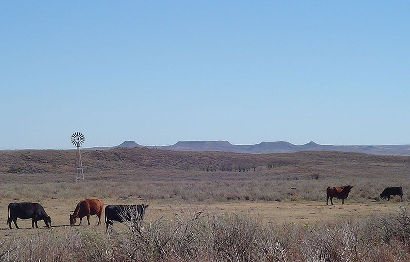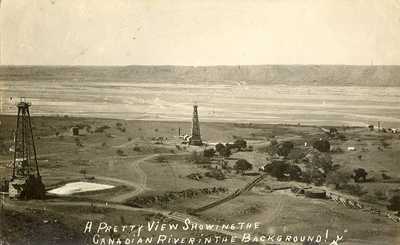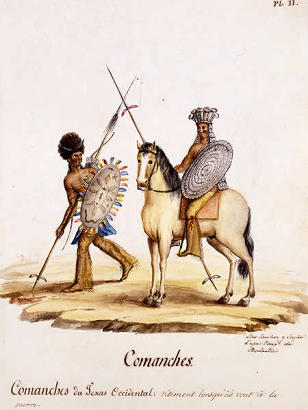|
Books by
Jeffery Robenalt
|
|
| During
the years 1856 to 1858, Comanche raids on the Texas frontier began
to escalate in both number and ferocity, as settlers encroached further
into the Comancheria, plowing under valuable hunting grounds. Ironically,
matters came finally to a boil when four white outlaws disguised as
Comanches massacred James B. Cambren and his two sons, who were plowing
a new field on their homestead bordering the Brazos River in the far
northwest corner of Young
County. Two additional settlers, Thomas Mason and his wife Mary,
were also slaughtered when they heard the shots and attempted to come
to the aid of the Cambren family. |
|
|
Hardin
Runnels
Wikimedia Commons |
To make matters
worse, President James Buchanan had recently ordered the bulk of the
2nd U.S. Cavalry, who had been providing protection to the settlers
in West Texas, to withdraw and ride north to Utah, where they participated
in what came to be known as the “Mormon War.” Ignoring reports that
the Young County
atrocities were committed by white men, Texas Governor Hardin Runnels
used the murders to fan the fires of racial hatred and justify his
request to the legislature for the establishment of a battalion of
Texas Rangers. The legislature approved the request on January 27,
1858, and Runnels immediately appointed long-time Texas Ranger,
Major John Salmon “Rip” Ford to command the new battalion.
Rip Ford had earned his nickname during the Mexican war while serving
as Jack
Hays’ regimental adjutant and medical officer. As medical officer,
Ford was required to sign the regiment’s death certificates, and he
always annotated them with R.I.P., for rest in peace. Governor Runnels
issued explicit orders to Ford to “…inflict maximum punishment. I
impress upon you the necessity of action and energy. Follow any trail
and all trails of hostile or suspected hostiles you may discover and
if possible, overtake and chastise them if unfriendly.” Ford was to
brook no interference from any source, even the remnants of the United
States Army, who might try to enforce the law against trespassing
on Indian Territory. |
|
|
"John
Salmon Ford, Photographed while serving as a Colonel in the Confederate
2nd Texas Cavalry during the War Between the States. Original photograph
circa 1860 to 1865; accessed 2010-07-31 at the Civil War Preservation
Trust website."
-
Wikimedia Commons
|
Major
Ford’s fist action was to travel north, gathering volunteers along
the way, who would join him at a temporary base camp near Fort
Belknap. The camp, located at the junction of the Clear Fork of
the Brazos and Hubbard’s Creek in northern Palo
Pinto County, was dubbed Camp Runnels. The veteran Ranger
chose his officers carefully. Most, like Edward Burleson, had seen
service in the Mexican American War or were old time Rangers like
Allison Nelson, James H. Tankersly, William Preston, Shapley Ross,
and Henry McCulloch. Ford also asked Shapley Ross’s son, Sul, to lead
a troop of Tonkawa
and Waco scouts. Sul Ross was only nineteen, but already experienced
in leading men. Every Ranger in the battalion was armed with at least
two Colt
revolvers and a long rifle, and Ford boasted that his men “could
shoot 1,500 rounds without the need to reload.”
On April 22, Rip Ford headed his 102 Rangers north from Camp Runnels,
along with several supply wagons and an old army ambulance. Two days
later, while crossing the Prairie Dog Branch of the Red River into
Greer County,
the force was augmented by 113 of Sul Ross’s Tonkawa and Waco scouts
led by Chief Placido and John Pockmark, both eager to seek revenge
against their hated enemies. After the rendezvous, the column continued
to move north, fording the North Fork of the Red River a week later
and officially entering Indian Territory. Ford later said that he
had never considered not crossing the Red River, since his mission
“was to find Indians, not learn geography.”
Once again the column moved out, this time with the Tonkawa
and Waco warriors ranging well ahead, but more than week passed before
the scouts brought back news of recent Comanche camps strung out along
the Washita River. Continuing to make his way north, Ford led the
expedition along the course of the Washita watershed until the column
reached the False Washita River late in the afternoon of May 11. From
a vantage point on a rise above the old road that ran between Fort
Smith and Santa Fe, Ford and Shapley Ross spotted a small band of
Comanche hunters chasing buffalo in the valleys off to the north.
Realizing that the main Comanche village he sought must be nearby,
Ford ordered the Rangers to set up a cold camp and to keep their noise
to a minimum.
After nightfall, Ford dispatched his scouts north with orders to fan
out and locate the camp of the hunters he and Shapley had spotted
earlier in the afternoon. The veteran Indian fighter realized that,
in order to maintain the element of surprise, it would be necessary
to attack the small camp and silence the warriors before they had
an opportunity to spread the alarm to the main village. The scouts
soon returned with news that the hunting camp was located in a small
valley of the Antelope Hills only a few miles distant.
|
 |
Antelope Hills
Photo by Denny Mingus - Wikimedia Commons |
| The long column
of Rangers and reserve warriors rode out well before sunrise. Placido
and his Tonkawa warriors claimed the privilege of launching the attack
on the unsuspecting hunting camp, and Ford gladly granted their request.
The Tonkawas effected complete surprise, overrunning the small camp
in a short, bitter struggle. Most of the women and children were taken
prisoner, but the Comanche braves preferred death to the humiliation
of captivity and not a single warrior escaped. A short time later,
as the rising sun slowly crept over the hills to the east, the Ranger
column came into view of the Comanche village nestled down in a grassy
meadow on the north bank of the Canadian
River, near the mouth of Little Robe Creek. |
 |
| As the Rangers
and reservation warriors sat their horses gawking at the village,
a solitary Comanche was spotted riding south, evidently heading toward
the hunting camp recently destroyed by Placido’s Tonkawa. Screaming
their war cries, the scouts lit out in pursuit. The startled Comanche
reined around and galloped for river, splashing across ahead of his
pursuers and bolting into the village to spread the alarm. However,
the warrior’s escape inadvertently revealed the location of a shallow
ford that spanned the treacherous, quicksand-laden waters of the Canadian.
Ford signaled for young Ross to ride ahead and cross with his scouts
to secure the far bank until the Rangers could maneuver into position.
When the Rangers reached the riverbank, Ford led them across the shallow
river and quickly formed a skirmish line facing west toward the village,
with the Ross and his warriors on the right. At Ford’s signal, the
line moved slowly forward. |
Map of Canadian
River Watershed
Wikimedia Commons |
| The ominous rumble
of drums echoed across the flats along the Canadian,
as an impressively mounted war chief, waving a long feathered lance
and wearing a bonnet of otter fur and eagle feathers, rode out from
the center of the village at the head of a line of warriors, screaming
insults at the approaching Rangers and hated Indian scouts. The Comanche’s
chest was covered by a coat of Spanish chain mail that gleamed in
the morning sunlight, and the Tonkawa spoke among themselves in hushed
tones that the mailed warrior was none other than the infamous Pohebits
Quashno, or Iron Shirt. As the magnificently attired Comanche war
chief galloped back and forth in front of the Rangers and scouts,
occasionally loosing an arrow from his short bow, several rifles were
discharged in his direction without any effect. In response, Ford
finally gave the order to fire a volley, and the Comanche was knocked
off his horse. As Iron Shirt came to his feet, a second volley put
him down for good. Ford then ordered his men to secure their long
rifles, draw their Colts,
and charge. |
 |
"Comanches
of West Texas in war regalia. Painting by Lino Sánchez y Tapia, circa
1830s. Courtesy of the Gilcrease Museum, Tulsa, Oklahoma."
- Wikimedia Commons |
|
Many of the
warriors who had formed the battle line behind their vaunted war
chief faltered at his death and fled from the assault. The few Comanches
who attempted to hold their ground were overwhelmed and brutally
gunned down, as the Rangers and reservation warriors galloped through
their depleted ranks, Colts
blazing. Ford reined up when he reached the outskirts of the village
and watched as his Rangers and Indian scouts attacked in all directions.
Individual Comanche warriors and their women and children bolted
from their teepees and fled toward the hills to the north and west
of the village. Vengeful Rangers chased the warriors down, killing
any man who attempted to stand and fight. Switching the cylinders
on their cap-and-ball revolvers was cumbersome on horseback, but
most of the Texans carried two or more of the rapid-firing Colts,
and the onslaught continued without letup.
A small group of Comanche warriors gathered to the west of the village
on the banks of Little Robe Creek in a desperate attempt to delay
the Rangers while their families escaped into the hills. The delaying
action was briefly successful, and several groups of women and children
were saved, but the valiant effort cost the warriors their lives.
None of them managed to escape the wrathful Rangers. A running battle
soon developed in the hills to the north and west of the village,
and the chase continued into the early afternoon, stretching across
the prairie for more than six miles. Eventually, Ford saw that his
men’s horses were near exhaustion and that both powder and ball
were running low, so he ordered the Rangers to return to the village
and reform. It was well they did.
Shapley Ross was one of the last men to return to the village, and
he found Ford once again forming the Rangers and reservation Indians
into a line of battle. “What are you in line of battle for?” he
asked Ford. Ford pointed to the hills north of the village and calmly
replied, “Look at the hills there, and you will see.” Looking down
on the village were more than 400 of Chief
Peta Nocona’s warriors drawn up in full battle array. The two
forces faced off for nearly and hour; during which time a series
of individual combats took place between the Comanche and Tonkawa.
Ford later commented that “…the mind of the spectator was carried
back to the days of chivalry; the joists and tournaments of knights…the
whole performance was a novel show to civilized man.”
However, after watching his Indians being bested time and again
by the fearsome Comanche, Ford grew tired of the game and ordered
Placido and his Tonkawa
to advance. The veteran Indian fighter hoped to lure the Comanche
down out of the hills, but Peta Nocona refused to take the bait.
His impatience growing, Ford finally ordered the Rangers to advance
at the trot. As the Rangers neared the Comanche line, Ford ordered
a charge, and the Rangers galloped toward the Comanche with drawn
Colts. Lieutenant Nelson took that moment to strike the enemies’
left flank, and the Comanche line was broken. Once again, a running
fight developed that stretched for several miles across the rolling
hills north of the Canadian, but the Comanche short bows were no
match for the firepower of the Rangers’ rapid-firing Colts.
At Peta Nocona’s expert direction, the Comanches continued an orderly
retreat from one covered area to the next, fighting a series of
delaying actions to screen the withdrawal of his village and the
survivors of Iron Shirt’s village. By late afternoon, Ford realized
that both his men and their horses were again near exhaustion, and
he called a halt to the fighting, ordering his Rangers and Indians
to return to the village along the Canadian. Two Rangers were killed
in the fierce fighting and five wounded, but they killed 76 Comanche
warriors, took 18 women and a few children prisoner, and captured
more than 300 horses. That evening the Rangers looted and burned
the village, and in a gruesome feast, the Tonkawa
cooked and ate some of the hands and feet of the dead Comanche warriors.
Early the following morning, Ford led his men south.
The weary column returned to Camp Runnels on May 21. In his report
to the governor, Ford stressed that the expedition had proved so
successful that all Indians in northwest Texas should be similarly
pursued and defeated as soon as possible. Ignoring the role played
by the reservation Indians, the veteran Indian fighter claimed that
his 100 Rangers had met and defeated an enemy force four times their
size. Governor Runnels read the report to the Texas legislature
and had it printed in all the newspapers, which made Ford a widely
celebrated hero. However, Runnels refused to allow the veteran Ranger
to continue the mission, when he learned that all authorized funds
had been expended, and he ordered Ford to immediately disband his
battalion of Rangers. The onset of the Civil War prevented any similar
actions against the Comanche for the next several years, and the
focus of Governor Runnels would soon switch south to the Rio Grande.
© Jeffery
Robenalt
"A Glimpse of Texas Past"
November 4, 2012 Column
jeffrobenalt@yahoo.com
References
›
|
References
for "Battle of Antelope Hills"
|
Cox, Mike (1991)
The Texas Rangers; Eakin Press; Austin, TX; ISBN 0-89015-818-5.
Fehrenbach,
T. R. (1974) The Comanches: The Destruction of a People;
Knopf Press; New York, NY; ISBN 0-394-48856-3.
Fehrenbach,
T.R. (2000) Lone Star: A History of Texas and the Texans;
Da Capo Press, NY; ISBN 0306809427.
Ford, Salmon
John (1987) Rip Ford’s Texas: Personal Narratives of the West:
Edited by Stephen B. Oates: University of Texas Press; Austin, TX;
ISBN 0292770348.
McCaslin, Richard
B. (2011) Fighting Stock: John S. “Rip” Ford of Texas (The
Texas Biography Series); Texas Christian University Press; ISBN
0875654215.
http://westernamericana2.
blogspot.com/2009/12/battle-of-antelope-hills.html.
http://www.forttours.com/
pages/antelope.asp.
John Salmon
Ford from the Handbook of Texas Online.
|
|
|
